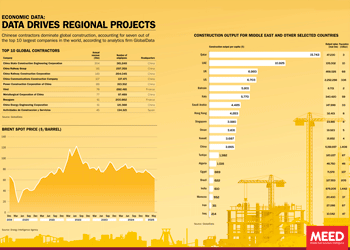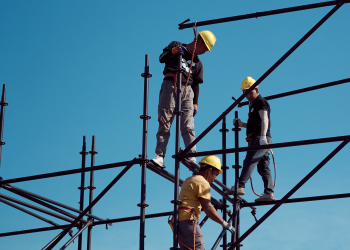Saudi Arabia’s power sector motors on
11 September 2024

Saudi Arabia’s power sector has sustained its project activity momentum over the past six months.
The principal buyer, Saudi Power Procurement Company (SPPC), awarded the contracts to develop two publicly-tendered wind independent power producer (IPP) projects, with a total combined capacity of 1,100MW, under the fourth round of the kingdom’s National Renewable Energy Programme (NREP).
The Public Investment Fund (PIF), responsible for procuring through direct negotiations 70% of the kingdom’s 2030 target renewable energy capacity, let three large-scale solar photovoltaic (PV) projects with a total combined capacity of around 5,500MW.
State majority-owned Saudi Aramco also awarded a contract to develop an independent cogeneration project with an electricity generation capacity of 475MW.
During the same period, SPPC began the tendering process for two combined-cycle gas turbine (CCGT) projects, the Remah and Nairiyah IPPs, each with a capacity of 3,600MW, and for four solar PV schemes with a total combined capacity of 3.7GW under the NREP fifth round.
“It has been a very busy summer,” notes a senior executive with an international utility developer, referring to the submission of bids in August for the contracts to develop the Remah 1 & 2, Nairiyah 1 & 2, and the NREP round-five solar PV schemes.
Notably, the principal buyer has initiated the selection process for consultants who will advise on its next pair of independent CCGT power plants – the 2,400MW Al-Rais and the 3,600MW Riyadh 16 projects.
Saudi Electricity Company (SEC) and SPPC are also understood to be conducting bilateral talks for the development of five CCGT power plants, which, along with those currently being built or tendered, support the kingdom’s mandate to replace fleets running on liquid fuel.
Essentially, the reported SEC projects, each with a capacity of 1,500MW-2,000MW, bear some similarities to PIF’s directly negotiated renewable energy schemes.
These projects help substantiate previous reports that SEC has been seeking to lock in gas turbine equipment deals with a total capacity of 30GW, in line with an overall capacity expansion plan within and outside Saudi Arabia.
The next few years can only get busier, with Saudi Arabia's Energy Minister, Prince Abdulaziz Bin Salman Bin Abdulaziz Al-Saud, confirming in June plans to tender 20,000MW of renewable energy projects annually starting this year, in line with reaching 100GW-130GW of installed capacity by 2030, "depending on electricity demand growth".
This represents a major upward revision to the official 2030 renewable energy capacity target of 58,700MW.
However, it is unclear if this new target considers the renewable capacity that will be installed to power Neom, Saudi Arabia’s largest gigaproject, as well as the requirement of green hydrogen projects that the PIF plans to codevelop.
Wind IPPs
In May, SPPC awarded a team led by Japanese utility developer Marubeni Corporation the contracts to develop the 600MW Al-Ghat wind and 700MW Waad Al-Shamal wind IPPs.
The team of Marubeni and its partner, the local Alajlan Brothers, is also expected to win the contract to develop the 700MW Yanbu wind IPP, the final wind scheme included in NREP’s round four.
These are important awards for Marubeni, which last won an IPP contract in Saudi Arabia in 2021 for the 300MW Rabigh solar scheme.
Notably, the Al-Ghat and Waad Al-Shamal wind IPPs will be developed at world-record-low levelised electricity costs of $c1.565 a kilowatt-hour (kWh), or roughly 5.87094 halalas/kWh, and $c1.70187/kWh or 6.38201 halalas/kWh.
PIF projects
In June, three Saudi utility developers and investors signed power-purchase agreements (PPAs) with SPPC to develop and operate three solar PV projects with a combined capacity of 5,500MW.
The Haden and Muwayh solar PVs, located in Mecca, will each have a capacity of 2,000MW, while the Al-Khushaybi solar PV power plant in Qassim will be able to generate 1,500MW of electricity.
The team that will develop the three projects consists of Acwa Power, PIF-backed Water & Electricity Holding Company (Badeel) and Saudi Aramco Power Company (Sapco), a subsidiary of the state majority-owned oil giant.
The project companies formed for each solar IPP have since signed financing documents for the projects, which will require a total investment of SR12.3bn ($3.3bn). The financing sought was $2.6bn.
These projects comprise round four of PIF’s Price Discovery Scheme, with Acwa Power as the preferred developer partner.
Energy storage systems
The scale of new conventional and renewable energy capacity being developed in the kingdom – some 3,500MW of solar PV and wind capacity is now online, with over 10,500MW under construction – has increased the urgency to build energy storage systems to balance the kingdom’s energy system and stabilise its grid.
SPPC has signalled plans to procure gigawatt-sized battery energy storage systems (bess) using an IPP model. The tendering process for the first bess IPP package is expected to begin by the year-end or early 2025.
In parallel, National Grid Saudi Arabia, an SEC subsidiary, has started awarding contracts to build energy storage systems capacity using an engineering, procurement and construction (EPC) model. The local Algihaz Holding is understood to have won the contracts to build four energy storage systems in Najran, Madaya and Khamis Mushait, which will have a total combined capacity of 7.8 gigawatt-hours (GWh).
Also in August, SEC tendered contracts for the construction of five battery energy storage systems with a total combined capacity of 2,500MW, or roughly 10GWh.
The planned facilities, each with a capacity of 500MW or roughly 2GWh, are located in or within the proximity of the following key cities and load centres:
- Riyadh
- Qaisumah
- Dawadmi
- Al-Jouf
- Rabigh
Saudi Arabia’s plan to build its first large-scale nuclear power plant in Duwaiheen, which appeared to be making progress before October last year, has faced delays following shifting geopolitics involving stakeholders that include the US and Israel. The tender bid deadline for nuclear technology providers is understood to have been postponed and no new date has been set.
As it is, Saudi Arabia’s ever-expanding power projects pipeline, particularly for renewables and bess, will require investors, contractors and lenders to allocate sizeable resources, perhaps more than they have historically done in the past, over the next several years as various stakeholders endeavour to meet Vision 2030-tied peak demand scenarios.
This applies less to CCGT projects, which, pending a clear carbon-capture strategy from the offtaker or the Energy Ministry, appear to attract a decreasing number of developers and investors.
Exclusive from Meed
-
 June 2025: Data drives regional projects
June 2025: Data drives regional projects30 June 2025
-
 UAE-Turkiye financial links strengthen
UAE-Turkiye financial links strengthen30 June 2025
-

-
 Iraq approves Basra housing project
Iraq approves Basra housing project30 June 2025
-
 Meraas announces Dubai City Walk expansion
Meraas announces Dubai City Walk expansion30 June 2025
All of this is only 1% of what MEED.com has to offer
Subscribe now and unlock all the 153,671 articles on MEED.com
- All the latest news, data, and market intelligence across MENA at your fingerprints
- First-hand updates and inside information on projects, clients and competitors that matter to you
- 20 years' archive of information, data, and news for you to access at your convenience
- Strategize to succeed and minimise risks with timely analysis of current and future market trends

Related Articles
-
 June 2025: Data drives regional projects
June 2025: Data drives regional projects30 June 2025
Click here to download the PDF
Includes: Top 10 Global Contractors | Brent Spot Price | Construction output
To see previous issues of MEED Business Review, please click herehttps://image.digitalinsightresearch.in/uploads/NewsArticle/14171168/main.gif -
 UAE-Turkiye financial links strengthen
UAE-Turkiye financial links strengthen30 June 2025
 This package on UAE-Turkiye relations also includes:
This package on UAE-Turkiye relations also includes:> UAE-Turkiye trade gains momentum
> Turkiye’s Kalyon goes global

Turkish bank DenizBank is one of Turkiye’s leading private banks and, as a wholly owned subsidiary of Emirates NBD since 2019, it is playing a leading role in developing business links between the UAE and Turkiye.
Recep Bastug, who was appointed as DenizBank’s CEO in 2024, says there is great potential for trade between the two countries.
“Turkiye is a growing country,” he says. “We’ve had volatility over the past five years, but the Turkiye economy and the banking sector have been able to manage those periods successfully.”
Having spent years with international institutions such as BBVA, Bastug has vast experience in the banking sector. “Turkish banks, especially private ones like DenizBank, are very successful. In terms of capital, balance sheet structure and digital transformation, we are in a strong position,” he says.
 Solid fundamentals
Solid fundamentalsTurkiye’s fundamentals remain solid with a diversified export-oriented economy, a young and skilled population of 85 million, and relatively low debt levels. “We are not a highly leveraged country. Our household debt-to-GDP ratio is low. With the right policy mix, we offer high potential for foreign investors,” says Bastug.
That potential is increasingly being realised through growing engagement with the GCC and the UAE. “Turkiye’s connection with the Gulf is going up, and DenizBank is set to play a serious role in these relations. Day by day, Turkish companies are expanding their footprint in the region.”
GCC projects
Baştug says that many of these companies approach DenizBank to help facilitate their entry into Gulf markets. “Some of our clients are extremely well capitalised, but others need support for major projects. Just recently, one Turkish company announced a $3bn project in the region. We’re helping them connect with Emirates NBD and navigate the local financial landscape.”
DenizBank is actively supporting the creation of trilateral partnerships – particularly between Turkiye, the UAE and Saudi Arabia. “We see huge opportunity in forming financial strongholds across these markets, leveraging Turkiye’s contractor experience, the UAE’s capital and Saudi Arabia’s scale,” says Baştug.
DenizBank is already delivering results. “With Emirates NBD, we’ve identified 10 strategic cooperation areas, including trade finance, payments and capital markets. Thanks to this partnership, Emirates NBD has become the number one debt capital markets bank in Turkiye, even ahead of global players.”
One area of growing activity is initial public offering (IPO) participation. “We’ve launched a mutual fund that allows Turkish private banking clients to participate in IPOs from the region, including from the UAE and Saudi Arabia. It’s a diversification strategy and helps retain wealth within the group.”
Turkiye’s connection with the Gulf is going up, and DenizBank is set to play a serious role in these relations. Day by day, Turkish companies are expanding their footprint in the region
Recep Bastug, DenizBankInflation ends
Despite the current inflationary environment, Bastug says there is a clear inflection point ahead. “We expect 2027 to be a turning point. Once we exit the inflationary accounting regime [in Turkiye], DenizBank will become one of the biggest contributors to Emirates NBD’s global balance sheet. Last year, we contributed $1.2bn. In 2027, it will be significantly more.”
DenizBank is the fifth-largest private bank in Turkiye with about a 5% market share. “The largest private bank is at 13%. It’s not easy to close that gap – but we will do it. Our long-term goal, aligned with our shareholder, is to become the biggest and most successful private bank in the country.”
The bank is especially focused on agriculture, SMEs, and export financing – sectors that are deeply relevant to
Turkiye’s economic growth and to regional demand. “We are the leading agricultural bank in Turkiye, and we believe strongly in the sector’s future – both for local consumption and exports.”Regional opportunities
Bastug also sees potential for engagement beyond the GCC, including in post-conflict reconstruction. “In the past, Turkiye had strong trade volumes with Syria. Even during wartime, commercial links remained. Once a stable environment emerges, there will be opportunities – especially in infrastructure.”
While a physical branch presence is not currently being considered, DenizBank is prepared to support Turkish contractors operating in neighbouring countries. “We have the relationships and expertise to facilitate this growth. And culturally, we’re well aligned with the region – it helps make business smoother.”
As Turkiye re-establishes economic momentum and Gulf economies look to deliver on long-term visions, DenizBank is positioning itself for a more active role in the region in the future. “We are preparing the bank for the next stage, and with the backing of Emirates NBD, we’re confident in our ability to lead.”
READ MORE
> UAE-Turkiye trade gains momentum
> Turkiye’s Kalyon goes globalhttps://image.digitalinsightresearch.in/uploads/NewsArticle/14170372/main.gif -
 Multiply agrees to sell Pal Cooling to Tabreed and CVC
Multiply agrees to sell Pal Cooling to Tabreed and CVC30 June 2025
Abu Dhabi-based investment company Multiply Group has agreed to sell all of its shares in its district cooling subsidiary Pal Cooling Holding (PCH) for AED3.8bn ($1bn) to a consortium comprising Engie-backed National Central Cooling Company (Tabreed) and CVC DIF.
The transaction is still subject to regulatory approvals.
MEED exclusively reported in May that a team comprising Tabreed and CVC was holding exclusive discussions to acquire PCH.
Multiply Group initially acquired a 100% stake in PCH and its subsidiaries in July 2021.
Multiply Group has been advised by Standard Chartered and Clifford Chance. Tabreed and CVC DIF have been advised by Citi, Synergy Consulting and White & Case.
The transaction brings together two of the UAE’s leading district cooling players. PCH was founded in 2006 and operates five active district cooling plants across the UAE. The company maintains eight long-term concessions and strategic partnerships with some of the UAE’s leading real estate developers, servicing key residential, commercial and mixed-use developments – most notably on Abu Dhabi’s Reem Island.
Tabreed owns and operates 92 plants, including 76 in the UAE, five in Saudi Arabia, eight in Oman, one in Bahrain, one in India and one in Egypt, in addition to other international projects and operations.
https://image.digitalinsightresearch.in/uploads/NewsArticle/14170511/main.jpg -
 Iraq approves Basra housing project
Iraq approves Basra housing project30 June 2025
Iraq has approved plans to build a housing project in Basra that will offer about 5,000 homes in the first phase to tackle the country’s rising housing shortage.
The project, which is endorsed by Iraq’s National Investment Commission (NIC), will cover an area of about 3 square kilometres.
According to local media reports, Basra province governor Asaad Al-Idani said the project has already been awarded to a developer.
Iraq has been gradually recovering since the war. The government initially prioritised infrastructure and public housing to stimulate economic growth, improve living standards and attract foreign investment.
More recently, benefitting from higher oil prices and a period of relatively stable governance, Baghdad has expanded its focus to reconstructing and modernising the country’s deteriorating infrastructure.
The Iraqi construction market has also seen significant investments from private real estate developers from the region. In May, Egyptian real estate developer Ora Developers announced that it had started construction on the Al-Wardi residential city project, which consists of more than 100,000 residential units covering about 61 million square metres (sq m) on the southeastern side of Baghdad.
The move is the latest sign of international investors’ growing appetite for developing real estate in Iraq as part of the country’s post-war building initiatives.
Also in May, another Egyptian firm, Talaat Moustafa Group Holding, said it was in negotiations with the NIC to develop a mixed-use project. The project, which will cover an area of about 14 million sq m and will be located in the southwest of Baghdad, is expected to contain about 45,000 residential units.
The positive sentiment has been particularly buoyed by a robust 2024 budget, which allocated nearly $42bn to transport, social infrastructure and housing initiatives.
Looking ahead, Iraq’s construction industry is expected to register an annual average growth rate of 4.9% in 2025-28, supported by further investments in energy, infrastructure and housing projects, according to UK analytics firm GlobalData.
MEED’s June 2025 report on Iraq includes:
> COMMENT: Iraq maintains its pace, for now
> GOVERNMENT & ECONOMY: Iraq’s economy faces brewing storm
> OIL & GAS: Iraqi energy project value hits decade-high level
> PIPELINES: Revival of Syrian oil export route could benefit Iraq
> POWER: Iraq power sector turns a page
> CONSTRUCTION: Iraq pours billions into housing and infrastructure projects
> DATABANK: Iraq forecast dips on lower oil priceshttps://image.digitalinsightresearch.in/uploads/NewsArticle/14170011/main.png -
 Meraas announces Dubai City Walk expansion
Meraas announces Dubai City Walk expansion30 June 2025
Register for MEED’s 14-day trial access
Local real estate developer Meraas has announced the City Walk Crestlane project as it continues to expand its City Walk residential community in the Al-Wasl area of Dubai.
The City Walk Crestlane comprises two residential towers offering 198 one-, two-, three-, four- and five-bedroom units.
The project is expected to be completed and handed over by the third quarter of 2028.
Earlier this month, Meraas, which is part of Dubai Holding Real Estate, awarded a construction contract for another project at City Walk.
The local firm Naresco Contracting was awarded a AED450m ($123m) contract for the main construction works on its Central Park Plaza residential project at City Walk.
The project involves constructing two towers with 23 and 20 floors. Together, they will have 212 residential units.
In May, Meraas awarded another local firm, Al-Sahel Contracting Company, a AED300m contract for the main construction works on Elara, which is phase seven of the Madinat Jumeirah Living masterplan in Dubai.
The project involves building three residential towers with 234 apartments.
https://image.digitalinsightresearch.in/uploads/NewsArticle/14169472/main.jpg

